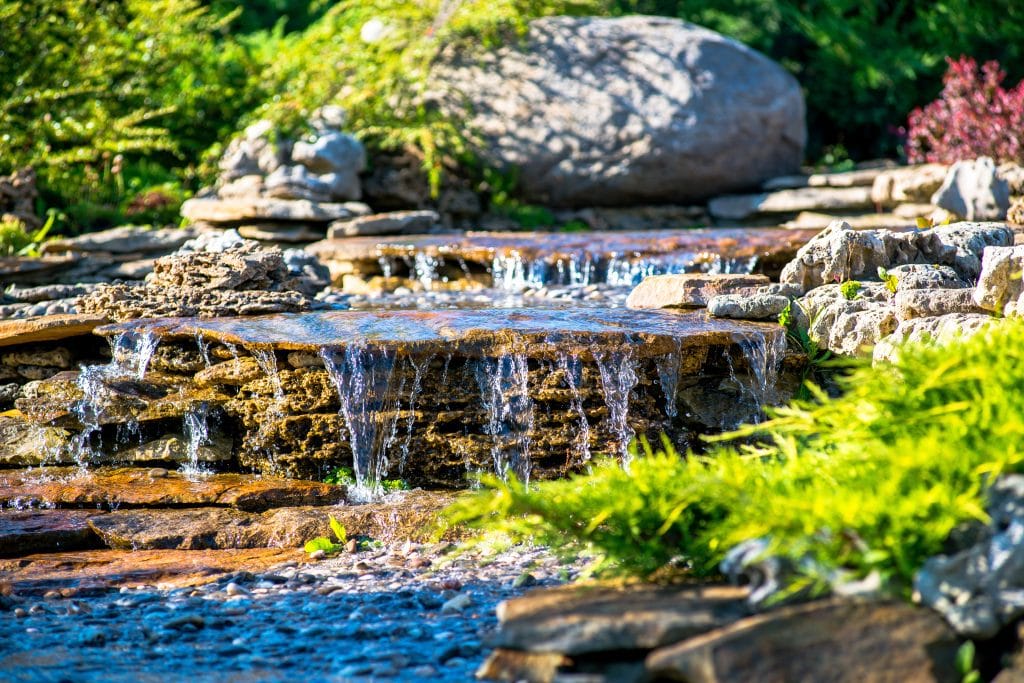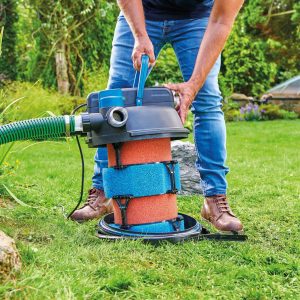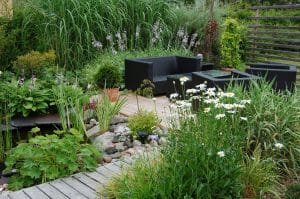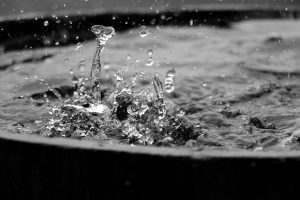
What Is A Biofalls and Why Does Your Pond Need It? A Comprehensive Overview
A Biofalls is a natural filter system designed for ponds that helps maintain water clarity and quality. Adding a Biofalls to a pond can greatly improve its ecosystem by reducing harmful substances and supporting aquatic life. This system combines both filtration and aesthetic benefits, making it an essential feature for any pond owner.

With a Biofalls, you get a multi-functional component that not only cleans the water but also creates a gentle waterfall effect. This not only enhances the visual appeal of the pond but also adds vital oxygen to the water, promoting a healthier environment for fish and plants. Knowing its importance can inspire pond owners to consider installing one for a thriving aquatic habitat.
Understanding the components and maintenance of a Biofalls is crucial for maximizing its benefits. A well-installed Biofalls system can lead to less time spent on cleaning filters and more time enjoying the beauty of a clean and healthy pond.
Key Takeaways
- A Biofalls improves pond water quality and clarity.
- It adds aesthetic beauty and oxygen to the pond environment.
- Proper maintenance enhances its filtration capabilities and longevity.
The Essentials of a Biofalls
A biofalls is a type of filtration system designed for ponds. It combines biological filtration with aesthetic appeal. The biofalls not only helps keep water clean but also adds a natural waterfall feature to the pond.
Key Components of a Biofalls:
Biological Filter Media:
- This material provides a surface for beneficial bacteria to grow. These bacteria break down harmful substances in the water.
Waterfall Feature:
- The flowing water creates a beautiful visual element. It also increases oxygen levels in the water, benefiting fish and plants.
Pump System:
- A reliable pump circulates water through the biofalls. It ensures adequate flow for effective filtration and waterfall movement.
Benefits of a Biofalls:
Improved Water Quality:
- By filtering out debris and harmful chemicals, biofalls maintain a healthy pond environment.
Support for Aquatic Life:
- The biofalls helps create a balanced ecosystem. Fish and plants thrive in cleaner, well-oxygenated water.
Low Maintenance:
- Once installed, a biofalls requires minimal upkeep. Routine checks and cleaning are usually sufficient.
Incorporating a biofalls into a pond can transform it into a cleaner, more attractive space. It serves both functional and aesthetic purposes, making it a worthy addition.
Function and Importance of Biofalls

Biofalls play a crucial role in maintaining the health of a pond. They aid in natural water filtration and improve clarity by hosting beneficial bacteria that break down waste. This process is vital for keeping the pond ecosystem balanced.
Natural Filtration Process
Biofalls systems rely on a combination of physical and biological filtration. Water flows through the Biofalls filter, where bacteria colonise the media. These beneficial bacteria consume harmful substances, such as ammonia and nitrites, produced by fish waste and decaying plants.
As organic material decomposes, these bacteria convert toxic substances into less harmful ones. This process enhances water quality, making it safer for fish and plants in the pond. The more efficient the filtration, the healthier the entire pond ecosystem becomes.
Role in Water Clarity
Water clarity is essential for the overall health of a pond. Biofalls help to maintain this clarity by breaking down pollutants and algae. Clear water allows sunlight to penetrate deeper, supporting plant growth and oxygen production.
When beneficial bacteria thrive in the Biofalls, they reduce the growth of harmful algae. Less algae leads to improved water transparency, creating a more visually appealing pond. This clear environment is crucial for fish and aquatic plants, promoting a balanced habitat.
Components of a Biofalls System

A Biofalls system consists of several key components that work together to maintain clean and healthy water in a pond. Each part plays an essential role in filtration and water circulation, contributing to the overall health of the aquatic ecosystem.
Filter Mats and Media
Filter mats are critical in a Biofalls system. They provide a surface for beneficial bacteria to grow. These bacteria help break down fish waste and organic matter, improving water quality.
Biological media, such as ceramic rings or foam pads, can also be part of the system. These materials increase the surface area for bacteria, enhancing the filtration process. Regular cleaning or replacement is necessary to ensure these components remain effective.
Choosing high-quality filter mats and media can significantly impact pond health. Regular maintenance helps optimise their function, ensuring a clear and balanced water environment.
The Spillway
The spillway is the area where water flows out of the Biofalls unit. It allows water to cascade back into the pond, creating a visually appealing waterfall effect. This movement not only enhances aesthetics but also adds oxygen to the water, which is vital for fish and plants.
Water quality can be affected by how well the spillway is designed and maintained. A properly shaped spillway prevents clogging and ensures a consistent flow of water. For best results, ensure that the spillway is free from debris and positioned at the correct height to optimise water flow.
Biofalls Housing
The Biofalls housing is the structure that contains the filter mats and biological media. It is typically made from durable materials such as plastic or concrete. The design of the housing is crucial for efficient water movement and easy maintenance.
It must be large enough to accommodate sufficient filter media while allowing for proper water circulation. Many Biofalls units are also equipped with access doors for easy cleaning. Choosing a robust design will ensure longevity and effectiveness in maintaining pond health.Finding the right Biofalls housing can greatly influence performance and maintenance efforts.
Types of Biofalls

Biofalls come in different models and brands, each designed for specific pond needs. Understanding these types helps in selecting the right option for effective pond filtration and aesthetics.
Standard vs. Advanced Models
Standard Biofalls are simpler designs that feature basic filtration systems. They often include a mesh or mat for mechanical filtration and sometimes provide biological options. These models are cost-effective and work well for small to medium ponds.
In contrast, Advanced Biofalls offer more sophisticated features. For instance, they may include multiple chambers for enhanced biological filtration. Advanced models often have built-in water pumps, adjustable flows, and improved materials for durability. Brands like Aquascape Biofalls are known for integrating innovative technology, making them suitable for larger or complex pond systems.
Comparing Brands
Different brands offer unique features in their Biofalls models. Atlantic Water Gardens provides robust designs that are easy to install and maintain. Their Biofalls are often appreciated for their large filtration areas, which improve water quality.
Big Bahama is another well-regarded brand, focusing on high-capacity systems. Their models typically allow for increased water flow, which is essential for larger ponds.
Aquascape Biofalls stands out for innovation. Their designs typically incorporate advanced filtration technologies that promote healthier pond ecosystems. When choosing a Biofall, comparing these options based on the specific needs and size of the pond is vital.
Installation Process

Installing a biofalls can enhance a backyard pond or watergarden. This section outlines how to choose the best location for installation and provides simple steps to ensure a successful setup.
Choosing the Optimal Location
Selecting the right spot for a biofalls is crucial. It should be near the pond for easy water flow but slightly elevated. This elevation helps the water flow naturally down into the pond.
Look for a place that avoids direct sunlight all day. Too much sun can encourage algae growth. A partially shaded area is ideal. Checking for natural slopes can also make the installation easier.
Ensure that the site is accessible for maintenance. It should be near pathways or open spaces. A good location will enhance the aesthetics of the pond and improve its overall function.
Steps to Install
Gather Materials: Before starting, collect all necessary items. This includes the biofalls unit, tubing, rocks, and any plants for decoration.
Excavate the Area: Dig where the biofalls will sit. Ensure the ground is level. If the site has a slope, adjust as needed.
Set the Biofalls: Place the biofalls in the dug-out area. Make sure it is stable and secure.
Connect the Tubing: Attach the tubing from the pump to the biofalls. Check for tight connections to prevent leaks.
Test the Water Flow: Turn on the pump to check the flow. Adjust if necessary for even distribution back into the pond.
Add Decorative Elements: Finally, use rocks or plants to blend the biofalls with the surroundings. This will create a natural look and enhance the beauty of the watergarden.
The Role of Skimmers in Conjunction with Biofalls
Skimmers play an important role in keeping ponds clean and clear. When used alongside biofalls, they enhance the pond’s overall health and aesthetics. The following sections explore why skimmers are beneficial and how they integrate with biofalls effectively.
Why Pair with a Skimmer?
Pairing a skimmer with biofalls helps manage pond cleanliness by removing debris. The skimmer acts as a mechanical filter, trapping leaves, twigs, and other organic matter before they sink. This prevents buildup, which can lead to algae growth and decreased water quality.
Skimmers work by drawing water through a skimmer box. This box prevents larger debris from entering the pond, helping to maintain a healthy ecosystem. Regular maintenance of the skimmer is essential to ensure it functions correctly. This partnership with biofalls maximises filtration, promoting clear water and a vibrant pond habitat.
Skimmer and Biofalls Integration
Integrating a skimmer with biofalls creates an efficient filtration system. The skimmer pulls water in, allowing debris to be collected before it reaches the biofalls. This arrangement ensures that the biofalls only deal with cleaner water, enhancing their ability to support beneficial bacteria.
When the cleaner water flows into the biofalls, it is further filtered and aerated. As a result, the pond remains clearer for longer periods. Proper installation is crucial so the water flows smoothly between both systems. Together, the skimmer and biofalls provide effective water management, boosting the pond’s health and beauty.
Maintaining Your Biofalls
Regular upkeep of a biofalls system is essential for its performance. Proper cleaning and a consistent maintenance schedule help ensure a healthy pond environment.
Cleaning Best Practices
Cleaning a biofalls should be done carefully to avoid harming beneficial bacteria. Begin by turning off the pump to prevent water flow. Remove and rinse the filter pads gently, avoiding harsh chemicals. Instead, use pond water to preserve helpful microorganisms.
When cleaning, check the bioballs and lava rock. Rinse them as needed to remove debris. Remove any excess sludge or organic matter. This will help maintain good water quality.
Always inspect the entire system for any signs of blockage. Blocked water flow can lead to problems. Regular cleaning keeps everything functioning as it should.
Regular Maintenance Schedule
A regular maintenance schedule keeps the biofalls clean and effective. It’s advisable to perform a thorough cleaning every 4 to 6 weeks during the growing season.
In addition to regular cleanings, monitor water levels and quality weekly. Check for any damage to the filter pads or plumbing. Replace worn parts promptly to avoid bigger issues.
Conduct a more detailed inspection quarterly. Look over the entire biofalls system for any signs of wear, leaks, or blockages. Proper maintenance extends the lifespan of the biofalls and improves pond health.
Enhancing Biofalls With Aquatic Plants
Adding aquatic plants to a biofall can improve both its appearance and function. These plants provide natural filtration and create a healthier environment for pond life. They can also enhance the aesthetic appeal of the pond.
Suitable Plant Choices
When selecting plants for a biofall, consider options that thrive in wet conditions. Good choices include:
- Water lilies: They float on the surface and provide shade.
- Cattails: Their tall, slender stems add height and interest.
- Hornwort: This submerged plant helps oxygenate the water.
- Pickerel weed: Known for its beautiful purple flowers, it attracts pollinators.
These plants not only beautify the pond but also help maintain water quality. It’s essential to choose plants compatible with the specific conditions of the pond, such as sunlight and water depth.
Benefits of Aquatic Flora
Aquatic plants offer several key benefits. First, they improve water clarity by absorbing nutrients. This helps reduce algae growth, creating a cleaner pond.
Second, plants provide habitat and shelter for fish and other pond wildlife. Their roots create safe spaces for small creatures and encourage biodiversity.
Lastly, the presence of plants enhances the natural look of the pond. They soften edges and create a more inviting environment. Overall, aquatic flora plays a vital role in maintaining a healthy and beautiful biofall.
Common Problems and Solutions
Maintaining a pond can lead to some common issues. Two major problems are algae growth and fish waste. Each can impact the health of the pond and its ecosystem.
Addressing Algae Growth
Algae can quickly become a problem in ponds, especially during warm months. It can make the water look murky and can harm fish and plants.
To combat algae:
- Clear Debris: Remove leaves and organic matter that can feed algae.
- Limit Nutrients: Reduce excess nutrients by controlling runoff and not overfeeding fish.
- Use Plants: Introduce aquatic plants that consume nutrients and provide shade.
- Algae Treatments: Use algaecides or natural treatments if growth becomes excessive.
Regular monitoring can help keep algae in check.
Managing Fish Waste
Fish waste can pollute pond water and lead to poor conditions. Accumulated waste releases harmful toxins and can elevate nutrient levels, encouraging algae blooms.
To manage this:
- Regular Cleaning: Clean the pond and remove waste regularly.
- Install Filters: Use biofilters that break down waste and improve water quality.
- Monitor Fish Population: Ensure the number of fish is balanced for the pond size to reduce waste build-up.
- Aerate the Water: Improve oxygen levels to help beneficial bacteria break down waste.
Addressing fish waste effectively will enhance the pond’s health and clarity.
Impact of Biofalls on Pond Ecosystem
Biofalls play a crucial role in maintaining a healthy pond ecosystem. They enhance water circulation, which is vital for distributing nutrients throughout the pond.
Better circulation helps to ensure that oxygen reaches all areas of the water. This oxygen is essential for fish and beneficial bacteria. Increased surface area from the features of biofalls promotes gas exchange.
Biofalls also provide a natural filtration system. The waterfall action helps to break up debris and allows particles to settle. This process improves water clarity and quality.
Additionally, biofalls create habitats for various organisms. Aquatic plants and beneficial microorganisms thrive in these environments. These organisms contribute to the pond’s overall biodiversity.
Installing a biofalls can prevent harmful algae blooms. With improved circulation and filtration, nutrients become balanced. This balance is necessary for a stable ecosystem.
In summary, biofalls positively impact the pond’s health. They support better oxygen levels, water clarity, and biodiversity. Their role is essential for maintaining a thriving aquatic environment.
Advantages of Biofalls Over Traditional Filters
Biofalls offer several enhancements compared to traditional pond filters. They provide superior filtration, add natural beauty to the pond, and can lead to cost savings over time.
Efficiency and Effectiveness
Biofalls are known for their powerful biological filtration capabilities. Unlike standard filters that may rely heavily on mechanical processes, Biofalls use a combination of mechanical and biological filtration. This enables them to break down harmful substances in the water more effectively.
The unique design allows for greater surface area for beneficial bacteria to thrive. These bacteria help to decompose organic matter, keeping the pond cleaner and healthier. This dual action often results in clearer water and a more balanced ecosystem.
Aesthetic Benefits
One of the standout features of Biofalls is their visual appeal. They can be integrated into the pond’s landscape, creating a natural waterfall effect. This adds charm and tranquillity to the outdoor space.
Additionally, the flowing water contributes to oxygenation, which is beneficial for aquatic life. The gentle sound of falling water can also enhance the atmosphere around the pond. This makes Biofalls an attractive choice for those looking to improve their pond’s appearance.
Long-Term Cost Savings
Investing in Biofalls can lead to long-term cost savings. Traditional filters often require frequent replacement and maintenance, which can add up. Biofalls, on the other hand, are designed for durability and efficiency.
They can reduce the need for chemical treatments and manual cleaning, which further lowers costs over time. While the initial investment may be higher, the benefits of reduced maintenance and healthier pond conditions justify this cost.



